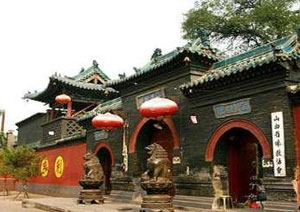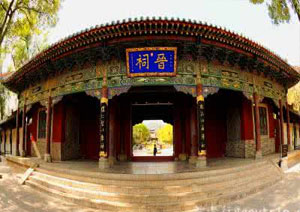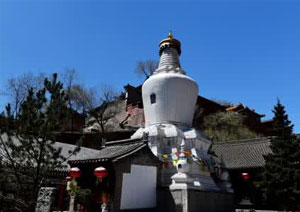 Chongshan Temple is located on Huangmiao Lane, Wuyi Road, in Taiyuan. First built in the Tang dynasty (618-907), it was once called White Horse Temple. In 1381, the temple was renovated and extended by the third son of Emperor Zhu Yuanzhang, the first emperor of the Ming dynasty, in memory of his mother, and renamed Chongshan Temple. Most of the temple was destroyed during the reign of the Qing Emperor Tongzhi (1856-1875). Covering an area of 40.4 acres, the temple has become an important cultural site under the protection of Shanxi Province and is home to the Buddhist Association of Shanxi Province.
Chongshan Temple is located on Huangmiao Lane, Wuyi Road, in Taiyuan. First built in the Tang dynasty (618-907), it was once called White Horse Temple. In 1381, the temple was renovated and extended by the third son of Emperor Zhu Yuanzhang, the first emperor of the Ming dynasty, in memory of his mother, and renamed Chongshan Temple. Most of the temple was destroyed during the reign of the Qing Emperor Tongzhi (1856-1875). Covering an area of 40.4 acres, the temple has become an important cultural site under the protection of Shanxi Province and is home to the Buddhist Association of Shanxi Province.
 Jinci Temple, located at the foot of Xuanweng Mountain to the southwest of Taiyuan, is one of the most important historical sites under special protection of the Shanxi Province. Jinci Temple was built in the Bei Wei dynasty (386-534 AD) in memory of Shuyu, the second son of the Zhouwu kingdom. The temple compound has ancient halls, pavilions, and towers, all surrounded by the mountains where ancient trees soar to unbelievable heights. The Saintly Mother's Hall, built from 1023 to 1032 during the Song dynasty, is the most magnificent and oldest building in Jinci Temple. It is regarded an important example of Song dynasty architecture.
Jinci Temple, located at the foot of Xuanweng Mountain to the southwest of Taiyuan, is one of the most important historical sites under special protection of the Shanxi Province. Jinci Temple was built in the Bei Wei dynasty (386-534 AD) in memory of Shuyu, the second son of the Zhouwu kingdom. The temple compound has ancient halls, pavilions, and towers, all surrounded by the mountains where ancient trees soar to unbelievable heights. The Saintly Mother's Hall, built from 1023 to 1032 during the Song dynasty, is the most magnificent and oldest building in Jinci Temple. It is regarded an important example of Song dynasty architecture.
 Twin Pagoda Temple, also known as Yongzuo Temple, was originally constructed in 1608 during the Ming dynasty. The two 53-meter-tall pagodas in the temple provide its name. Together, the twin pagodas are the symbol of Taiyuan. Each octagonal pagoda has 13 stories and is almost 55 meters high, made entirely of bricks and stone. The exterior is decorated with exquisite flying eaves. All the buildings in the temple were constructed with gray bricks. The temple houses a rare collection of steles bearing the works of famed calligraphers from various dynasties including Wang Xizhi (303-361), Yan Zhenqing (709-785), Liu Zongyuan (773-819) and Su Dongpo (1037-1101).
Twin Pagoda Temple, also known as Yongzuo Temple, was originally constructed in 1608 during the Ming dynasty. The two 53-meter-tall pagodas in the temple provide its name. Together, the twin pagodas are the symbol of Taiyuan. Each octagonal pagoda has 13 stories and is almost 55 meters high, made entirely of bricks and stone. The exterior is decorated with exquisite flying eaves. All the buildings in the temple were constructed with gray bricks. The temple houses a rare collection of steles bearing the works of famed calligraphers from various dynasties including Wang Xizhi (303-361), Yan Zhenqing (709-785), Liu Zongyuan (773-819) and Su Dongpo (1037-1101).
 Wutai Mountain (Five Terrace Mountain), located between Beijing and Inner Mongolia in Shanxi Province, is one of China's four sacred Buddhist mountains, along with E'mei Mountain, Jiuhua Mountain and Putuo Mountain. The five peaks of Wutai Mountain represent the Buddha's crown, the five families of Buddha, the five wisdom lights, the five visceral organs, and the five elements. The northern peak reaches over 3,058 meters above sea level and is the tallest in northern China. There are many extremely powerful caves on Wutai Mountain: Vimilimitra Cave, Manjushri Cave, Samantabhadra Cave and Avolokitshvara Cave, where the 6th Dalai Lama spent six years in meditation.
Wutai Mountain (Five Terrace Mountain), located between Beijing and Inner Mongolia in Shanxi Province, is one of China's four sacred Buddhist mountains, along with E'mei Mountain, Jiuhua Mountain and Putuo Mountain. The five peaks of Wutai Mountain represent the Buddha's crown, the five families of Buddha, the five wisdom lights, the five visceral organs, and the five elements. The northern peak reaches over 3,058 meters above sea level and is the tallest in northern China. There are many extremely powerful caves on Wutai Mountain: Vimilimitra Cave, Manjushri Cave, Samantabhadra Cave and Avolokitshvara Cave, where the 6th Dalai Lama spent six years in meditation.
| Taiyuan Attractions List | |

